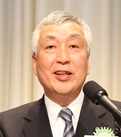°»Reconstruction of Kabuki Theater°…
March 23, 2011
Mr. Nobuyuki Onuma
Executive Vice President, Kabuki-Za Co., Ltd.
 °°Kabuki-za (theater) is currently undergoing reconstruction. Right now, numerous steel piles are being driven into the vacant lot surrounded by panels. The reconstruction started after the °»Farewell Performances°… had concluded last April, to which thousands of kabuki fans rushed during the exceptionally long 16-month performances. Many others took pictures or sketched the Kabuki-za building. A good proof of how much this building was loved by all.
°°Kabuki-za (theater) is currently undergoing reconstruction. Right now, numerous steel piles are being driven into the vacant lot surrounded by panels. The reconstruction started after the °»Farewell Performances°… had concluded last April, to which thousands of kabuki fans rushed during the exceptionally long 16-month performances. Many others took pictures or sketched the Kabuki-za building. A good proof of how much this building was loved by all.
°°The current reconstruction is supported by many, including the Agency for Cultural Affairs, the Tokyo Metropolitan Government, the Chuo Ward and the local people of Ginza. We drew together various opinions from wide-ranging fields as well as kabuki fans. We learnt that many wished to preserve the kabuki-za building as much as possible, some were even against demolishing it. We reached the conclusion to rebuild the whole building, as the antiquated kabuki-za built right after World War II had no adequate resistance to earthquakes nor room for barrier-free refurbishment.
°°Mitsubishi Jisho Sekkei Inc. and Mr. Kengo Kuma co-designed this new project, with Mr. Takashi Imazato as a theatrical supervisor. The construction is undertaken by Shimizu Corporation. The final plan is to rebuild the theater together with a 29-floor office building 35 meters behind it. The new theater entrance will preserve its original unique appearance, including the grand roof with tiles as well as the cusped gable.
°°Reconstructing the stage to exactly its original size is the most important in the whole reconstruction process: 27.3 meters wide, 6.3 meters deep, with a 18.2 meters long hanamichi (elevated walkway running from the stage to the rear of the theater through the audience) as well as the 18.2-meter-diameter revolving stage. Kabuki actors have long performed on this stage, thus even minor changes to its size will disturb their performances.
°°Kataoka Nizaemon XIII (1903-1994) was renowned for his excellent performance of Sugawara no Michizane (scholar, poet and politician during the Heian Period). He became almost blind in his later years, yet he performed everyday in a superb manner, walking across the stage, going down three steps and walking through the hanamichi to the rear of the theater and exited from the entranceway curtain. This was because he mastered the space and size of the stage, both in terms of body and soul, through many decades of performance.
°°A Kabuki stage is not merely a space, it is a historical space, on which numerous excellent actors have been performing for generations. Kanzaburo Nakamura XVIII told me he was filled with ineffable energy at the center of the stage, when he sensed his father and also his grandfather performed the same role on the same stage.
°°The new Kabuki-za stage must retain the long historical value handed down through generations. Now let me touch upon the °»stage made of hinoki cypress.°… The Kabuki-za stage needs 1,200 hinoki trees of more than 100 years old. We were fortunate to spot a forest with tens of thousands of hinoki trees planted 110 years ago at Tanzawa, Kanagawa Prefecture. We could procure high-quality lumbers with beautiful growth rings, which will be turned into boards for the stage at a sawmill in Mie Prefecture.
°°The new theater will have excellent acoustic effects, enabling the spectators to enjoy the live sound. It will also have more spacious seats and additional bathrooms. We gave thoughtful consideration to barrier-free design, including elevators installed and direct access from the subway station. Underground parking lots, roof garden and Kabuki Gallery are planned to be constructed.
°°Now, let me look back on the history of Kabuki-za. The theater was first built in 1889, as part of the °»movement to refine theatrical performance°… at the time when Westernization was sweeping across the country. The original building had a Western taste, while the interior had a Japanese style with traditional tiered seating. Kabuki-za was rebuilt into an entirely Japanese style building in 1911, but unfortunately it was burnt down from a short circuit in 1921. Construction for the 3rd building was delayed by the 1923 Great Kanto Earthquake. Yet thanks to the dedication by Mr. Takejiro Ohtani, President of Shochiku then, the building was completed in 1925 with a baroque Momoyama style. The theater was again heavily damaged by the 1945 Great Tokyo Air Raid during World War≠∂. It was restored in 1951 to become the 4th building, a symbol of cultural revival of Japan after the War.
°°I am sure many of you recall the excellent scenes performed on the stage of Kabuki-za. The 4th building was demolished last year, after the °»Farewell Performances°…, concluding its 60-year-history. Now let us all look ahead to the new Kabuki-za, which will be completed in the spring of 2013.